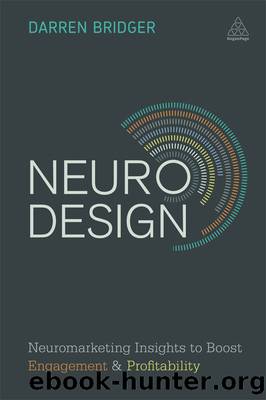Neuro Design by Darren Bridger

Author:Darren Bridger [Неизв.]
Language: eng
Format: epub
Publisher: Kogan Page
Published: 2017-01-11T02:10:35+00:00
Saliency mapping software
A number of different groups of academic neuroscientists have developed software algorithms that mimic the saliency mapping of humans. They are based on a number of sources of information, ranging from direct brain recordings from primates to eye-tracking studies on humans.13 Saliency mapping software takes a digital image or video and analyses it pixel by pixel, taking into account the surrounding pixels. It looks for low-level visual features such as colour, brightness and orientation of lines, and produces a topographic map showing the most visually salient areas. Within seconds the user can have a heat map that overlays on the image zones of hot or cold colours, illustrating those areas that are likely to grab the most or least visually salient-driven attention. The opposite format output, a fog map, instead covers up all the non-salient areas in a misty fog, making only the more salient areas visible.
These computer algorithm-based maps have then sometimes been validated against eye-tracking data of where people actually look.14 Researchers can subsequently improve the algorithm to up- or down-weight the importance of colour, brightness and orientation in order to mirror certain biases that humans have towards particular areas of their visual field (eg biases towards the upper or central areas of the visual field), or to reflect the tendency for people to look at text, or faces (both human and animal faces).15
Much of the impetus behind the development of these algorithms is to help computers to understand the visual world better, just as we as humans can. For example, enabling things like automatic detection of tumours in scan images, helping robots to navigate their surroundings, and automated centring and cropping of images around the most important object in the image.
Some of these algorithms are now available commercially to designers and marketers. They offer a more efficient way of rapidly testing the likely visual impact of designs than A/B testing on human participants.
In a similar experiment to the one that manipulated the visual saliency of food items, participants were presented with a series of photos of shop shelf displays of snack food items.16 Before the test they rated each item that would appear on a scale, depending on how much they would like to eat it (and they were asked not to eat for three hours before the study, to ensure they were hungry and motivated!). Again, the photos were shown relatively quickly (between a quarter of a second and just over three seconds). After looking at each shelf display (containing 28 snack items) they had to choose which item they would want. Whilst they were doing this, their eye movements were monitored using an eye-tracking camera. The saliency of the items was not artificially tinkered with, but instead was measured using a saliency mapping algorithm. First, from the eye tracking they found that for every second a participant looked at one item, it increased by 20 per cent the chance that they would subsequently select that item. Perhaps not surprising, as one might expect shoppersâ eyes to linger longer on things they are considering buying.
Download
This site does not store any files on its server. We only index and link to content provided by other sites. Please contact the content providers to delete copyright contents if any and email us, we'll remove relevant links or contents immediately.
Storytelling for dummies by Andrea Fontana(1493)
Effortless by Greg McKeown(1434)
The Practice by Seth Godin(1404)
Mastering Blockchain by Lorne Lantz(1392)
Blockchain Quick Reference by Paul Valencourt & Samanyu Chopra & Brenn Hill(1149)
Mastering Blockchain by Lorne Lantz & Daniel Cawrey(909)
The wind in the willows by Kenneth Grahame(849)
How to Lead by David M. Rubenstein(823)
The Ape in the Corner Office by Richard Conniff(792)
Social Media Engagement For Dummies by Aliza Sherman(711)
Handbook of Big Data Analytics by Unknown(711)
Taking Care of Yourself (HBR Working Parents Series) by Harvard Business Review(698)
Getting Started with Data: The first book you should read to successfully get along with data. by Menegatti Gabriel & Team Simbiose Ventures(693)
FunRetrospectives: activities and ideas for making agile retrospectives more engaging by Paulo Caroli & Tainã Caetano Coimbra(691)
Business Storytelling For Dummies by Unknown(670)
Evernote for Self Publishing: How to Write Your Book in Evernote from Start to Finish by Jose John(667)
Help! My Facebook Ads Suck-- by M. D. Cooper & Jill Cooper(653)
A Leader Listens by Ajay Banga(639)
Genius by Choice: Your unconventional A–Z handbook to enhance your learning process by Remondino Giulia S(638)
